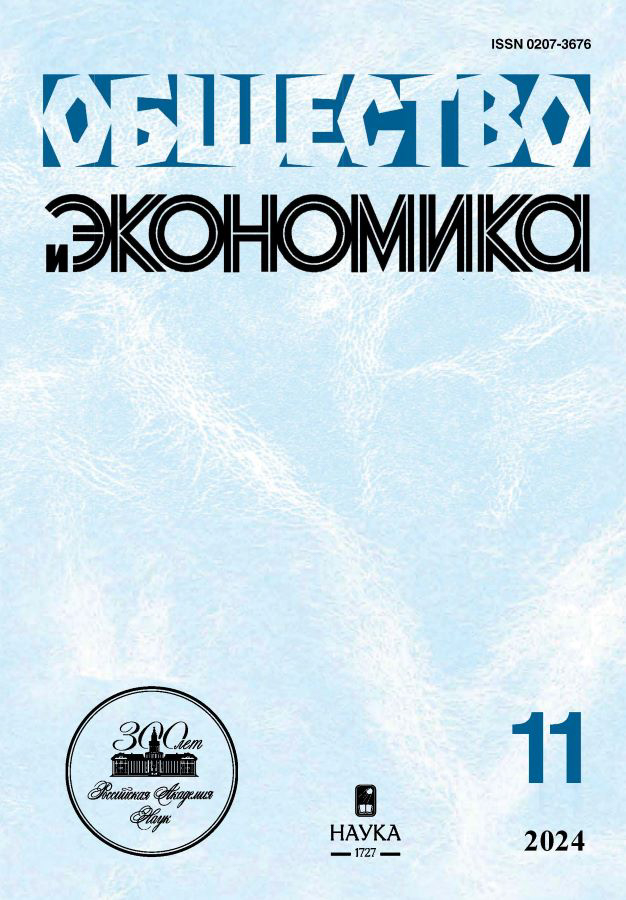Russia in the international movement of capital: adaptation to new conditions
- 作者: Kvashnina I.1
-
隶属关系:
- Institute of Economics (RAS)
- 期: 编号 11 (2024)
- 页面: 61-73
- 栏目: FINANCIAL POLICY
- URL: https://ruspoj.com/0207-3676/article/view/682699
- DOI: https://doi.org/10.31857/S0207367624110058
- ID: 682699
如何引用文章
详细
The article examines the impact of external sanctions and the Russian Federation’s response measures on cross-border capital flows. An analysis of the international investment position shows that after a record capital outflow through all channels in 2022, this process is slowing down, while other investments are seeing an inflow. Positive dynamics are also observed in Russian investments abroad. Despite increased external pressure, including through secondary sanctions, all participants in foreign economic activity are adapting to the new conditions. The governing bodies have formed a set of measures that allow for fairly effective control and regulation of capital flows. Most foreign companies in various forms remain in the Russian Federation or transfer production to friendly countries while maintaining the Russian market. Russian businesses are restructuring their assets, transferring them to other jurisdictions, buying companies abandoned by foreign owners, and looking for new markets and stock exchanges. At the same time, the adoption of mutual restrictions on cross-border capital flows has negative consequences and risks for the Russian economy. These include: increased volatility of the ruble due to the reduced influence of the financial account, increased debt burden; falling stock market liquidity; problems with enterprise management after the transition to Russian owners, technological backwardness, etc.
全文:
作者简介
Irina Kvashnina
Institute of Economics (RAS)
编辑信件的主要联系方式.
Email: irina.kvashnina@gmail.com
Ph.D. in Economics, Leading Scientific Associate
俄罗斯联邦, Moscow参考
- Квашнина И.А. Трансформация мировых потоков капитала // Международная экономика, 2022. № 10. С. 688–698.
- Банк России. Платежный баланс, международная инвестиционная позиция и внешний долг Российской Федерации в 2022 году. URL: http://www.cbr.ru/statistics/macro_itm/svs/p_balance/ (дата обращения: 20.11.2023).
- Центр макроэкономического анализа и краткосрочного прогнозирования (ЦМАКП). Тезис 9. Об оттоке капитала. URL: http://www.forecast.ru/_ARCHIVE/Mon_13/2023/TT2023_9.pdf (дата обращения: 20.08.2023).
- Банк России. Доклад о денежно-кредитной политике. №1(41), февраль 2023.
- Платежный баланс Российской Федерации (аналитическое представление). URL: https://www.cbr.ru/statistics/macro_itm/svs/ (дата обращения: 31.07.2024).
- Оценка ключевых агрегатов платежного баланса Российской Федерации. Июль 2024. URL: https://www.cbr.ru/statistics/macro_itm/svs/bop-eval/ (дата обращения: 31.07.2024).
- Квашнина И.А. Ограничения по трансграничным потокам капитала в условиях внешних санкций и ответных мер России // Общество и экономика, 2022. № 7. С.52–63.
- Шевцов А.Л. Возможная конфискация российских государственных активов на Западе: правовой и политический цугцванг // Вестник Института экономики Российской академии наук. 2024. № 3. С. 47–60.
- ЦБ оценил объем заблокированных активов на 30 ноября в 5,7 трлн рублей. URL: https://www.interfax.ru/business/883940 / (дата обращения: 12.08.2024).
- Число российских лиц под санкциями выросло более чем вдвое за 2023 год. URL: https://www.interfax.ru/russia/939405 / (дата обращения: 26.08.2024).
- Костин рассказал о росте отказов в платежах от дружественных банков. URL: https://www.rbc.ru/finances/11/04/2024/6617cbb19a7947c8c6001f9c (дата обращения: 12.09.2024).
- Банк России. URL: http://cbr.ru/press/event/?id=14546 (дата обращения: 10.10.2023); https://www.cbr.ru/press/event/?id=18421 (дата обращения: 12.09.2024).
- Кухарчук Г. Копытина О. Замещающие облигации: как получить выплаты по замороженным евробондам. URL: https://www.rbc.ru/quote/news/article/6352b95b9a7947fc6625d2c3 (дата обращения: 16.09.2024)
- Головнин М. Денежно-кредитная политика России: реакция на новые внешние вызовы // Вестник Института экономики Российской академии наук. 2023. № 1. С. 7–20.
- Перцева С. Россия в международном движении портфельных инвестиций и производных финансовых инструментов // Мировое и национальное хозяйство. 2023. № 4. С. 80–83.
- World Investment Report 2022 – International Tax Reforms and Sustainable Investment. N.Y. and Geneva: UNCTAD, 2022.
- Место уходящих иностранных компаний в экономике отраслей и регионов России // Доклад РЭУ им. Плеханова. 2023, Выпуск 1.
- В перечень экономически значимых организаций РФ включили еще три компании. URL: https://www.interfax.ru/business/965430 (дата обращения: 2.10.2024).
- Евдовина Т. Что они там наинвестировали // Коммерсантъ. 21.05.2024.
- Кузнецов А. Экспорт и импорт прямых инвестиций: история крупных российских потерь с начала ХХ века // Проблемы прогнозирования. 2023. № 4 (199). С. 32–41.
- Мордовина М. Продажи российских активов за рубежом выросли в 7 раз и превысили 1 млрд долл. URL: https://www.rbc.ru/finances/15/05/2024/66433ec19a79476f535c7287 (дата обращения: 5.10.2024).
补充文件











